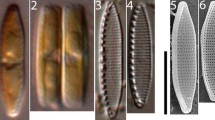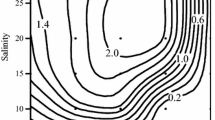Abstract
In 1987 effects of salinity fluctuations on growth of Ditylum brightwellii (West) Grunow, isolated from the Eastern Scheldt estuary (SW Netherlands) in 1981, were studied. D. brightwellii was grown in a 12 h light: dark cycle at constant salinity in brackish media. Ammonium-limited cultures were subjected to a salinity fluctuation. By decreasing the salinity to 4.8‰ photosynthesis and cell division were inhibited; cells were deformed. Protein and carbohydrate contents increased slightly, dark respiration was stimulated and cellular levels of glucose decreased at low salinity; this indicated a possible role of sugars in osmoregulation. Ammonium was accumulated in cultures, amino acids may have been stored; the role of the vacuole as a storage compartment was discussed. Both the ammonium uptake capacity and the affinity for ammonium decreased. Nitrogen limitation was relieved in the transient state. [With the activity of the nitrogen assimilation enzymes glutamine synthetase (GS) and glutamate synthase (GOGAT) being uninhibited by lower salinity.] Recovery from hypo-osmotic stress during a salinity increase was initiated by stimulated photosynthesis; chlorophyll a increased, but persistant contractions of cytoplasm (with chloroplasts) may have delayed cell growth. The glutamate dehydrogenase (GDH) activity decreased further whereas the cellular level of alanine increased in the presence of large ammonium pools; this may indicate a temporary activity of ADH (alanine dehydrogenase). Skeletonema costatum (Greville) Cleve, recovered faster from hypoosmotic stress than did D. brightwellii. Due to an osmotic shock from 13.6 to 7.1‰ S both species excreted amino acids and glucose; S. costatum accumulated more glucose, D. brightwellii accumulated more amino acids. S. costatum may with the competition for nitrogen in waters with an unstable salinity; it will replace D. brightwellii.
Similar content being viewed by others
Literature cited
Admiraal, W., Peletier, H., Laane, R. W. P. M. (1986). Nitrogen metabolism of marine planktonic diatoms; excretion, assimilation and cellular pools of free amino acids in seven species with different cell size. J. exp. mar. Biol. Ecol. 98: 241–263
Anderson, L. W. J., Sweeney, B. M. (1978). Role of inorganic ions in controlling sedimentation rate of a marine centric diatom Ditylum brightwellii. J. Phycol. 14: 204–214
Bakker, C., De Vries, I. (1984). Phytoplankton and nutrient dynamics in saline Lake Grevelingen (SW Netherlands) under different hydrodynamical conditions in 1978–1980. Neth. J. Sea Res. 18: 191–220
Balch, W. M. (1986). Exploring the mechanism of ammonium uptake in phytoplankton with an ammonium analogue, methylamine. Mar. Biol. 92: 163–171
Brand, L. E. (1984). The salinity tolerance of forty-six marine phytoplankton isolates. Estuar. cstl Shelf Sci. 18: 543–556
Brand, L. E., Guillard, R. R. L. (1981). The effects of continuous light and light intensity on the reproduction rates of twenty-two species of marine phytoplankton. J. exp. mar. Biol. Ecol. 50: 119–132
Canterford, G. S. (1980). Formation and regeneration of abnormal cells of the marine diatom Ditylum brightwellii (West) Grunow. J. mar. biol. Ass. U.K. 60: 243–253
Conway, H. L., Harrison, P. J., Davis, C. O. (1976). Marine diatoms grown in chemostats under silicate or ammonium limitation. II. Transient response of Skeletonema costatum to a single addition of the limiting nutrient. Mar. Biol. 35: 187–199
Dickson, D. M. J., Krist, G. O. (1987). Osmotic adjustment in marine eukaryotic algae: the role of inorganic ions, quaternary ammonium, tertiary sulphonium and carbohydrate solutes. I. Diatoms and a rhodophyte. New Phytol. 106: 645–655
Dickson, D. M. J., Wyn Jones, R. G., Davenport, J. (1982). Osmotic adaptation in Ulva lactuca under fluctuating salinity regimes. Planta 155: 409–415
Dortch, Q. (1982). Effect of growth conditions on accumulation of internal nitrate, ammonium, amino acids, and protein in three marine diatoms. J. exp. mar. Biol. Ecol. 61: 243–264
Eppley, R. W., Rogers, J. N., McCarthy, J. J. (1969). Half saturation constants for uptake of nitrate and ammonia by marine phytoplankton. Limnol. Oceanogr. 14: 912–920
Eppley, R. W., Rogers, J. N. (1970). Inorganic nitrogen assimilation of Ditylum brightwellii, a marine plankton diatom. J. Phycol. 6: 344–351
Fischer, H. (1986). Osmotic behaviour of some species of Melosira (Bacillariophyceae) from marine and inland waters. Bot. Mar. 29: 373–379
Gross, F. (1940). The osmotic relations of the plankton diatom Ditylum brightwellii (West). J. mar. biol. Ass. U.K. 24: 381–415
Guillard, R. R. L., Ryther, J. D. H. (1962). Studies of marine planktonic diatoms. I. Cyclotella nana Hustedt, and Detonula confervacaea (Cleve). Gran. Can. J. Microbiol. 8: 229–239.
Hellebust, J. A. (1976). Osmoregulation. Annu. Rev. Plant Physiol. 27: 485–505
Hitchcock, G. L. (1983). An examination of diatom are: volume ratios and their influence on estimates of plasma volume. J. Plankton Res. 5: 311–324
Jahnke, J., Baumann, M. (1983). Chemical and physical effects of the diatom Biddulphia sinensis Greville in batch cultures; a contribution to bioindication in phytoplankton ecology. Hydrobiol. Bull. 17: 5–20
Jüttner, F., Matuschek, T. (1978). The release of low molecular weight compounds by the phytoplankton in an eutrophic lake. Water Res. 12: 251–255
Lund, B. A. (1987). Mutual interference of amonium, nitrate, and urea on uptake of 15N sources by the marine diatom Skeletonema costatum (Grev.) Cleve. J. exp. mar. Bio. Ecol. 113: 167–180
Mague, T. H., Friberg, E., Hughes, D. J., Morris, I. (1980). Extracellular release of carbon by marine phytoplankton; a physiological approach. Limnol. Oceanogr. 25: 262–279
Martin-Jézéquel, V., Poulet, S. A., Harris, R. P., Moal, J., Samain, J. F. (1988). Interspecific and intraspecific composition and variation of free amino acids in marine phytoplankton. Mar. ecol. prog. Ser. 44: 303–313
Maske, H. (1982). Ammonium-limited continuous cultures of Skeletonema costatum in steady and transitional state: experimental results and model simulations. J. mar. biol. Ass. U.K. 62: 919–943
Paasche, E. (1968). Marine plankton algae grown with light-dark cycles. II. Ditylum brightwellii and Nitzschia turgidula. Physiol. Plant. 21: 66–77
Rijstenbil, J. W. (1987). Phytoplankton composition of stagnant and tidal ecosystems in relation on salinity, nutrients, light and turbulence. Neth. J. Sea Res. 21: 113–123
Rijstenbil, J. W. (1988). Selection of phytoplankton species in culture by gradual salinity changes. Neth. J. Sea Res. 22: 291–300
Rijstenbil, J. W., Sinke, J. J. (in press). The influence of salinity fluctuation on the ammonium metabolism of the marine plankton diatom Skeletonema costatum, grown in continuous culture. J. Plankton Res.
Rijstenbil, J. W., Mur, L. R., Wijnholds, J. A., Sinke, J. J. (1989). Impact of temporal salinity decrease on growth and nitrogen metabolism of the marine diatom Skeletonema costatum in continuous cultures. Mar. Biol. 101: 121–129
Rowell, P., Stewart, W. D. P. (1976). Alanine dehydrogenase of the N2-fixing blue-green alga, Anabaena cylindrica. Arch. Microbiol. 107: 115–124
Sakshaug, E., Andresen, K. (1986). Effect of light regime upon growth rate and chemical composition of a clone of Skeletonema costatum from the Trondheimsfjord, Norway. J. Plankton Res. 8: 619–637
Schobert, B. (1980). Proline catabolism, relaxation of osmotic strain and membrane permeability in the diatom Phaeodactylum tricornutum. Physiol. Plant. 50: 37–42
Schöne, H. K. (1974). Experimentelle Untersuchungen zur Ökologie der marinen Kieselalge Thalassiosira rotula. II. Der Einfluß des Salzgehaltes. Mar. Biol. 27: 287–298
Turpin, D. H., Hariison, P. J. (1978). Fluctuations in free amino acid pools of Gymnodinium simplex (Dinophyceae) in response to ammonia perturbation: evidence for glutamine synthetase pathway. J. Phycol. 14: 461–464
Wagner, G. J. (1979). Content and vacuole/extravacuole distribution of neutral sugars, free amino acids, and anthocyanin in protoplasts. Plant Physiol. 64: 88–93
Author information
Authors and Affiliations
Additional information
Communicated by O. Kinne, Oldendorf/Luhe
Contribution no. 427 Delta Institute for Hydrobiological Research, Yerseke, The Netherlands
Rights and permissions
About this article
Cite this article
Rijstenbil, J.W., Wijnholds, J.A. & Sinke, J.J. Implications of salinity fluctuation for growth and nitrogen metabolism of the marine diatom Ditylum brightwellii in comparison with Skeletonema costatum . Mar. Biol. 101, 131–141 (1989). https://doi.org/10.1007/BF00393486
Accepted:
Issue Date:
DOI: https://doi.org/10.1007/BF00393486




